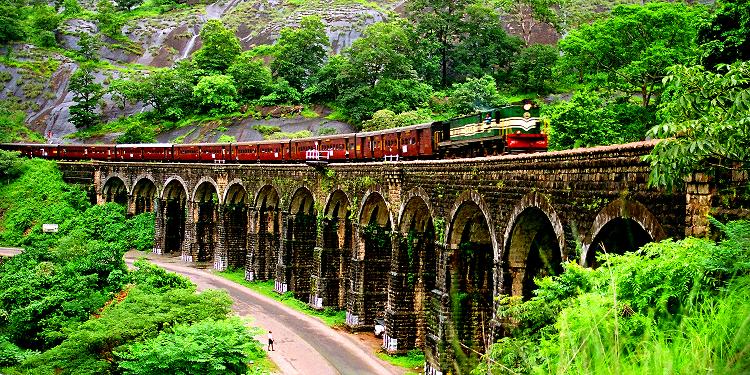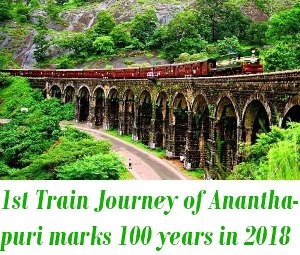First Train Journey of Thiruvananthapuram marks 100 years on the New Year day of 2018
This incident occurred exactly 100 years ago, exactly on January 1st, 1918. It was British Raj then, and its administrators were fully involved in developing transportation system across the nation, though for their personal benefits. Youth celebrated the event, while older generations responded to it in a strange way. The event shocked senior people a lot, while it was warmly welcomed by well-educated youngsters. Some of them were really scared, while a few others foresaw future developments of the city. Yes, it was the first train journey which took place in the Ananthapuri city on New Year eve, exactly 100 years ago.

Today, the whole world celebrates the New Year eve of 2018. Our country has advanced so far in all sectors of development. If it’s the case of railway transportation, India stands in the 4th position in terms of railway lines network, it owns some of the busy railway stations of the world and also one of the biggest sectors (8th highest) across the world giving employment to maximum people. It may appear unbelievable to younger generations that, when the first train ran for the first time in the capital city of the most literate state of the country of present scenario, due to superstitious beliefs, many of our ancestors who believed it to be a giant ghost, scared seeing the huge vehicle, a few ran away while some others fainted. Some even panned it to be a bad decision made by the government, while some others believed to be a British conspiracy.
Though it’s only 100 years apart, in the millennium number of years human race started existing here on earth’s surface, happenings and changes in the past one century can nowhere be compared with developments done by older generations existed 200 or 300 years ago or beyond that. So, on this wonderful eve of New Year, let us spare a few moments and travel a few steps backwards and collect some of the interesting memories of yesterdays, which look unbelievable in present conditions. A journey to the roots, let us try to find ourselves in the course of time which swifts fast in eye blink.
Thiruvananthapuram city on January 1st, 1918
The day of the arrival of the first train in Thiruvananthapuram city, senior people were very much shocked and scared with the British move. Some of them preached the rumours of the conspiracies of British government. They claimed that it’s the crookedness of British to accumulate soldiers and take them away through railway transport. In those days, youth was forced by British to join British army, though they were reluctant to do so. People belonging to conservative society then, expressed their grief and dissatisfaction to Travancore ruler, Sree Moolam Thirunal to approve it, the ruler who was then regarded as one of the greatest rulers who strives for the welfare of his subjects.
Youth supported the decision with whole heart, but others…….
Not only for the easy transportation between Kollam and Thiruvananthapuram, railway transportation provides easy transport to travel to any place across India – youth supported the decision stating this reason. Yet old people were not willing to get over their fear of ‘black ghost (Karimbhootham)’.
To welcome the ‘guest’, officials and youth started arrangements with enthusiasm, while women too were eagerly waiting to see ‘the black ghost’. At last ‘the ghost’ arrived accompanied by sound and whistles. Seeing the high speed black train with roaring voice and emitted smoke, children started crying, and women ran into homes and closed the doors in fear. In certain places like Chirayinkeezhu, many women fainted.
Old railway office doesn’t exist now

Started its first journey from Chakka of Thiruvananthapuram, the train ended its journey at Kollam. It’s exactly the same day when train service between Kollam and Thiruvananthapuram was started. There was a railway office and also a rest house then. The place was later converted to rubber works, and now a part of Thiruvananthapuram international airport.
Water transport was most common for long distance travel then
A. S. Canal (Thiruvananthapuram-Shornur Canal) used to be the main water route for long distance travel at the time when railway service began in Thiruvananthapuram. Boats (small and big in size) were mainly used for this purpose. For road transport, Villivandi, Jaduka and Feeten Vandi using large number horses were mainly used. From 1910 onwards, license was given for road vehicles. Yet motor vehicles were owned by only lesser number of people.
Railway service was started in Kerala in 1861
Railway service was started for the first time in Kerala in the year 1861 starting with Malabar, and the service was extended till Kochi in 1902. But it took more than 15 years to reach the southern tip of Kerala. Talks were made to organize a company to do the extension process, and connect Kochi with Travancore. Yet later preference was given by Travancore to extend the railway line from Chenkotta (Red Fort).
1904 November 26, Kollam-Chenkotta-Tirunelveli railway lines were opened, and very soon it reached Travancore also. Thus it opened a new form of transport for inhabitants of Kollam and Thiruvananthapuram to reach major parts of India, through the newly opened railway service which started from Kollam. In those days, students of Thiruvananthapuram used to travel to Kollam to watch the train which starts its journey from Kollam. Quite interesting!
Very soon Sree Moolam Thirunal, the ruler of Travancore expressed his desire to extend railway lines to state capital and British government granted permission too. Very soon South Indian Railway Company started their procedures for the extension of railway line.
In 1910-1911, land survey was completed. Sir Robert Gallus, an expertise played a magnificent role in the construction process. Construction of path was completed in superfast speed. 1000s of workers deployed for this purpose and British officials, and the combined efforts of both gave new sights to local people, which they never experienced before.
In between, resistance from locals and false stories and rumours also ruled the roost. Certain people spread rumours that human sacrifices were made to increase strength of bridges. As war time was going on, there was scarcity of equipments needed for construction as well. Yet the officials managed to complete the whole process within stipulated time. For the testing of railway lines, higher officials also reached Kerala.
Flag off for the first journey from Chakka
On 1918 January 1st, with grand celebrations train service flagged off from Chakka (Chackai). Divan of Travancore and higher officials who were invited for the first journey were present at the location before flag off. Railways provided sweets and simple meals for all those who were present at the occasion. When Ananthapuri’s first train began its first journey, the crowd welcomed the moment with cheers, claps and music accompanied by musical instruments. Some ladies welcomed the eve using traditional Kuravayidal (a unique voice made using mouth, done at auspicious occasions). Yet it took a few more years to begin railway service from Thampanur (current railway station).
You can read a few more articles related to Thiruvananthapuram- The capital city of Kerala, and the posts cover different topics. Click on the images in the gallery to read




















Recent Comments